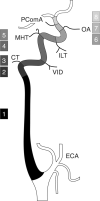Segmental agenesis of the internal carotid artery distal to the posterior communicating artery leading to the definition of a new embryologic segment
- PMID: 15313707
- PMCID: PMC7976531
Segmental agenesis of the internal carotid artery distal to the posterior communicating artery leading to the definition of a new embryologic segment
Abstract
We report a case of segmental agenesis of the right internal carotid artery (ICA) in a 53-year-old woman, associated with a saccular aneurysm of the left anterior cerebral artery (A1 segment) presenting with a right hemispheric transient ischemic attack. The agenetic segment was located distal to the origin of the posterior communicating artery (PComA), as documented both angiographically and by direct surgical inspection. This observation suggests the existence of a previously unrecognized embryologic segment of the ICA, located between the PComA origin and the terminal bifurcation of the ICA into the anterior and middle cerebral arteries.
Figures



Comment in
-
Segmental agenesis of the internal carotid artery distal to the posterior communicating artery leading to the definition of a new embryologic segment.AJNR Am J Neuroradiol. 2006 Feb;27(2):246-7; author reply 247. AJNR Am J Neuroradiol. 2006. PMID: 16484382 Free PMC article. No abstract available.
References
-
- Lasjaunias P, Santoyo-Vazquez A. Segmental agenesis of the internal carotid artery: angiographic aspects with embryological discussion. Anat Clin 1984;6:133–141 - PubMed
-
- Meder JF, Blustajn J, Trystram D, et al. Radiologic anatomy of segmental agenesis of the internal carotid artery. Surg Radiol Anat 1997;19:385–394 - PubMed
-
- Dilenge D. Bilateral agenesis of internal carotid artery. J Can Assoc Radiol 1975;26:91–94 - PubMed
-
- Lasjaunias P, Moret J, Mink J. The anatomy of the inferolateral trunk (ILT) of the internal carotid artery. Neuroradiology 1977;13:215–220 - PubMed
Publication types
MeSH terms
LinkOut - more resources
Full Text Sources
Medical
Miscellaneous
